Once more, Boca Raton city council is proving to be a watch dog with a bite without teeth. They should be watching out for the public good. But when it comes to choosing between the public good and developer good, city council refuses to bite the developer hands that feed them. And when it does, it’s a bite without teeth.
There is no doubt that affordable workforce housing is desperately needed in and around Boca Raton. Fortunately, the state passed a law, called the Live Local Act, to aggressively foster their development. Special incentives are offered for residential buildings, or mixed-use projects that are at least 65% residential, and where at least 40% of the units are affordable housing. These units must remain affordable, according to income standards set in the act, for at least 30 years. They can be in any commercial, industrial, or mixed-use zone.
Impacting single family zones
But before extolling the act, or looking at it in detail, let’s look at how the act can impact on neighborhoods. Pictured here is the block at East Palmetto Park Road and SE Olive Way, just the east of the bridge. There is a commercial building facing East Palmetto with single family homes in the rear.

The zoning map for that area shows four parcels of B1 (business) zoning, immediately backed by single family paarcels.

Under the Live Local Act, a 12-floor residential (picture Tower 155), or a mixed-use building with at least 65% residential, can be built there, without getting public input. In fact, the developer can bypass most zoning rules, only needing to meet setback and parking requirements. This could be prevented, but whenever city council stands up to developers, it’s a bite without teeth.

Preempts City Control and Resident Input
This could happen because the Live Local Act takes control away from local governments. The city is required to administratively approve projects with at least 40% affordable units. Cities must let the developer bypass many zoning rules and cannot require developers to apply for zoning or land use changes, special exceptions, conditional use approvals, variances, or comprehensive plan amendments. Developers are allowed increased height and density. Projects can be as tall as the tallest existing building within a mile, but with a minimum of three stories. And the act prohibits opening up hearings for public comments. Local residents lose their rights to speak out before city council.
These restrictions are meant to practically guarantee approval of affordable housing projects. However, cities need a developer willing to build a project that meets the 40% and other requirements. Generally, affordable housing is less profitable than luxury residences.
Developers prefer a smaller option
But there is an option in the act that give cities the option to approve projects with as low as 10% affordable housing. Under this option, developers still get special incentives and credits while maximizing their profit at the expense of affordable housing units. So, depending on location, a developer can build a 100-foot residential or mixed-use residential with just 10% affordable units.
The act also prohibits cities from implementing any type of rent control.
At just 10% affordable units, compared to 40%, developer profit would be higher. So, of course, developers prefer the 10% option. In fact, when this was discussed at the city council meeting August 22, land use attorney Bonnie Miskel spoke in favor of the 10% rule in order to make the new rules “profitable”. Can’t be more honest than that. And developer spokesperson Glenn Gromann commented that no builder would want to create a development that met the 40% restrictions.
Boca Raton city council (and many other cities) has been considering how to implement this act. And trying to decide if they are even able, under the act, to write their own ordinance. The legality of these ordinances is in question. Discussions are still going on.
For example, Orange County, Florida, passed an ordinance that restricts developers who use the Live Local Act to build on commercial property within 100 feet of a single-family home to build only townhomes or quadplexes. But developers question if that violates the law.
City Council takes a token stand
Here in Boca Raton, in a transparent show to supposedly stand up for the public good, city council wants to make the minimum number of affordable units 15%, far from the 40% intent of the law, and more pleasing to developers. They are also asking developers to let them know about density and height. As far as we know, they are not asking residents for their input. City council just refuses to bite the developer lobby in the hands.
City council can later claim they took a stand. But like a toothless dog, it’s just a bite without teeth. It doesn’t even break the skin of the developer lobby. They can use the Act as a loophole to allow buildings in density and height that would otherwise not be allowed. A win for developers. A loss for those needing affordable housing.

